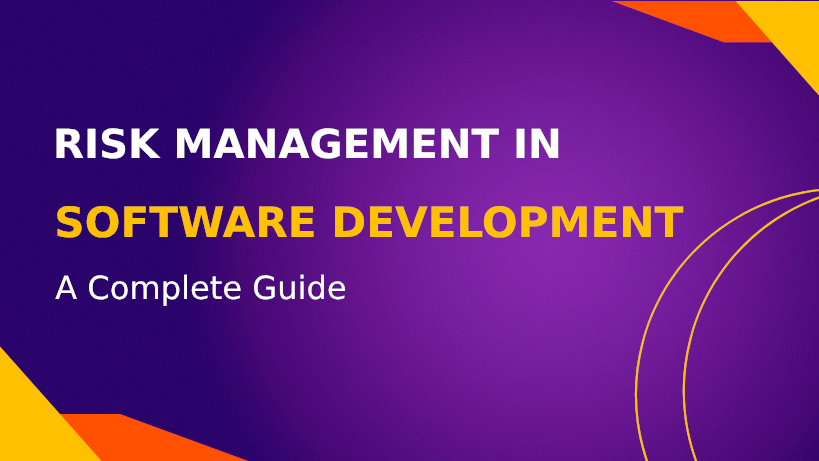
Introduction
With the fast software development age, effective risk management in software development is the key to ensuring a project's success. Risk management is key to the timely completion of projects, of good quality, and at cost, whether it is a mobile app, enterprise software, or web application.
Throughout this extensive tutorial, we will guide you through how risk management in software operates, what kinds of risks you will most likely encounter, and what actions to take to minimize these risks. We will also explore the part played by AnchorPoints in helping you use good risk management practices with your software development projects.
What is Risk Management in Software Development?
Risk management in software development is identifying, assessing, and ranking the expected risks throughout the development life cycle. The purpose is to minimize the effect of the risks and accomplish the project within time, cost, and scope.
Risk management is ongoing and takes place from the original planning stages to the software program's closure and maintenance stages. Risk management detects probable barriers to programming that will cause halting and determines techniques for escaping or avoiding around them.
Effective risk management in software development can advance enterprises by:
- Avoid project delays
- Maintain the quality of the software product
- Avoiding financial losses
- Ensure better resource allocation
- Improve customer satisfaction
Why is Risk Management Crucial in Software Development?
Software projects are inherently complex, with many variables that could lead to unexpected issues. When software systems are becoming more and more advanced, there is the most tendency for the project to fail as well. Risk management is one of the most important aspects of goal setting. A few of the most essential reasons to make risk management a priority are as follows:
- Uncertainty in Requirements: Most software development projects start with poorly defined or incomplete requirements. Scope creep is caused by miscommunication among stakeholders or user requirement changes, which hinders staying on track.
- Technical Challenges: A team at the development level could face technical challenges such as integration matters, coding mistakes, or performance issues, which can unsettle progress and hold delivery back.
- Team Dynamics: High turnover, inexperience, or poor collaboration among teams may result in inefficiency and low-quality code, further increasing project failure risk.
- Security Threats: Increased fear of cybersecurity threats makes software projects vulnerable to attack if security threats are not dealt with efficiently from the start.
- Budget and Time Constraints: Projects should be delivered on time and within budget. Not addressing risks leads to cost overruns, delays, rework, and a lack of adequate resources.
Types of Risks in Software Development
The categorization of different types of risks is the first step towards effective risk management in software development. They can be identified into a few types:
Project Management Risks
- Scope Creep: When the project scope continues to expand beyond the initial plan without appropriate adjustments to time and resources.
- Time and Budget Overruns: Overspending budgets or going beyond schedules most commonly occurs due to overly optimistic planning, unforeseen technical problems, or changed project scope.
- Poor Resource Allocation: Poor resources, i.e., insufficient staff or skill set, will slow development or impact quality.
Technical Risks
- Integration Problems: Problems are about integrating standalone software or third-party services, which may cause problems
- Legacy System Support: Legacy system support is dangerous mainly because of the exertion of old-fashioned technology or the non-existence of documentation.
- Code Defects and Quality: Poor coding, quick development, or insufficient quality testing are the causes of software defects and bugs in the software.
Security Threats
- Data Breaches: Inappropriate access to sensitive information causes substantial economic loss to the image of an organization.
- Vulnerabilities: System security vulnerabilities can be caused by faults in software, inadequate input controls, weak encryption, or lousy access.
Operational Risks
- Lack of Maintenance: A software system that is not updated regularly can quickly become obsolete or vulnerable to emerging security threats.
- Performance Issues: Loss of performance through inefficient code or inadequate hardware infrastructure can harm user experience.
Human Risks
- Skill Gaps: Incompetency or ignorance regarding some technologies can cause mistakes, inefficacy, and late completion of projects.
- Communication Breakdowns: Communication breakdown or uncollaboration between team members may result in missed requirements and conflicting goals.
Steps in Risk Management for Software Development
Risk management is not a singular process but cyclical throughout the software development process. The following is a step-by-step examination of how you can perform effective risk management in software development.
Identification of Risks
Identifying potential risks that affect your project is the first step in the process. Involve your team, including the project manager, the development team, or the client, to recognize risks. A SWOT analysis (Strengths, Weaknesses, Opportunities, and Threats) and brainstorming are the topmost proper means to identify internal and external risks.
Risk Analysis and Assessment
After threats are identified, their potential impact and probability of happening should then be determined. The probability may be measured through risk matrices where the risk is plotted with likelihood as one axis and impact as another.
Methods that can be utilized are:
- Qualitative Risk Assessment: A technique based on experience, judgment, and opinion.
- Quantitative risk assessment: A more structured approach with calculation techniques to estimate the probability and the loss if the action is taken.
Prioritization
Prioritize the risks after analysis based on probability and impact. Prioritize the high-priority risks first, which will have the highest impact on the project's success. Failure Modes and Effects Analysis (FMEA) and Risk Priority Number (RPN) are the tools used in Prioritizing.
Risk Mitigation and Strategy Development
The second risk management process step is devising the risk mitigation process and identifying ways to control, eliminate, and monitor the risks. For example, risk mitigation is creating a plan that includes preventive measures, corrective actions, and contingency plans for each high-priority risk.
One of the methods could be:
- Risk Avoidance: Change project scope, timeline, or approach to avoid specific falling risks.
- Risk Reduction: Introduce strategies that can diminish the probability or the number of impacts a defect might have on your testing budget.
- Risk Transfer: The risk passes from one party to another, for example, if somebody is contracted to perform some tasks.
- Risk Acceptance: Take the risk and be ready to grapple with it if it happens.
Risk Monitoring and Control
Risk management is continuous, and the risks are to be reviewed periodically throughout the project life cycle. This includes checking the risk assessment, evaluating the sufficiency of the mitigation plan, and updating the plan as new risks emerge. Use risk management tools like Jira, Trello, or Risk Register to track and document risks.
Risk Communication
Inform stakeholders of possible risks, mitigation strategies, and project status. Updating all stakeholders periodically keeps everybody in the loop and ensures that changes or amendments are addressed promptly.
Best Practices in Risk Management in Software Development
The following are the best practices that must be considered to make your risk management a success.
- Adopt Agile Practices: Agile practices help you manage risks incrementally by breaking up the project into smaller pieces and monitoring progress periodically.
- Invest in Quality Assurance (QA): Introduce reasonable testing procedures to find defects early on and prevent technical risks from snowballing out of control.
- Establish a Cooperative Environment: Foster open team communication to manage risks proactively.
- Use Risk Management Software: Use software and tools to assist in identifying, assessing, and tracking risks within your projects.
How AnchorPoints Can Help You Manage Risks in Software Development
Effective risk management in software development depends on experience, knowledge, and the right tools. At Anchorpoints.io, our specialty is providing complete risk management services tailored to your software development needs. This is how we can help you:
Risk Assessment and Consultation
We offer professional advice to assist you in determining and assessing your project's specific risks. Our professionals will conduct intensive risk analysis and assist you in developing tailored risk management plans.
Scalable and Agile Solutions
Through Agile practices, we help you respond to risks progressively and proactively, actively and effectively resolving changes and issues.
Proactive Mitigation Strategies
Our team develops effective risk reduction strategies, keeping you out of trouble and your project on schedule and within budget.
Ongoing Risk Monitoring
We provide ongoing risk monitoring and management throughout the software development life cycle, where risks are detected early, and appropriate mitigations are implemented.
Cybersecurity Expertise
As security threats increase, we offer specialist services to address cybersecurity threats during software development so your software remains secure and compliant with industry standards.
With AnchorPoints, you can mitigate risks effectively, improve the overall quality of your software, and deliver successful projects on time and budget.
Conclusion
In today's world of competitive software development, risk management is an essential part of successful project management rather than just good practice. Keeping yourself informed about the risks implicated and taking the proper steps are crucial components of the equation. Moreover, the skilled team at AnchorPoints will also greatly help, ensuring the project is on time, within budget, and meets high-quality requirements.
A well-thought risk management plan, if appropriately implemented, would prevent costly mistakes, improve agility, and if followed through, it will lead to firms being able to come up with high-quality standard software that addresses the goals of the business at the same time that it meets the customer's needs.
Ready to take control of your software development risks? Contact AnchorPoints today to learn how our expert risk management services can ensure your project stays on track, on budget, and meets your quality goals. Let's build your success together!






